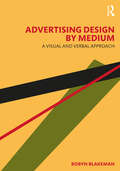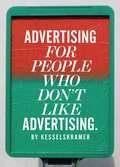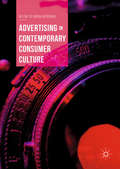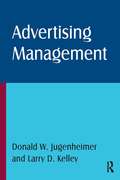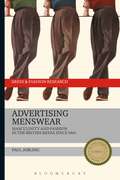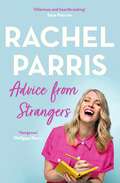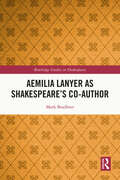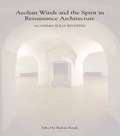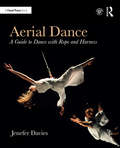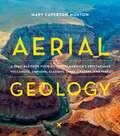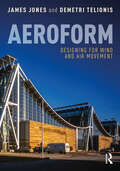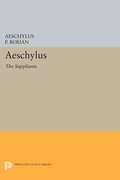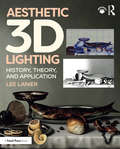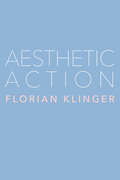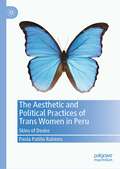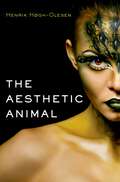- Table View
- List View
Advertising Design by Medium: A Visual and Verbal Approach
by Robyn BlakemanConceived to give readers the principles and the tools to create successful advertisements in a variety of mediums, this book is a detailed exploration of how visual and verbal elements of design work together to solve a business goal. Effective visual and verbal design solutions are more than just a good idea; they are purposeful, on-target, on-strategy, and recognizable no matter where, or in what form, they appear. Success depends on creative teams’ understanding of ideation, layout, type, color, varied image formats, copywriting, media advantages and limitations, and production procedures for varied media formats. The step-by-step approach of this book goes beyond broad theoretical discussions on copy and design. Instead, the book dissects the creative process into individualized and detailed discussions both creative and non-creative students alike can understand and employ. This book is ideal as a textbook for design courses within programs in advertising, graphic design, integrated marketing communication, strategic marketing, entrepreneurship, business, and mass communication. Accompanying the text are online materials for instructors: lecture slides, a testbank, and an instructor manual. www.routledge.com/9781032183596
Advertising for People Who Don't Like Advertising
by KesselsKramer KesselsKramerThis is a book by a company that dislikes advertising as much as anyone. Nevertheless, it makes adverts. It has worked with global brands to produce fashion collections and promoted a town with a mass wedding. It creates advertising with more human, truthful communications. The company's name is KesselsKramer.This book describes how to make something you like out of something you don't. As well as drawing on its own experiences, KesselsKramer listens and learns from those who doubt the advertising industry. Stefan Sagmeister explains how quitting work makes you better at working; Hans Aarsman discusses authenticity in image-making; and Alex Bogusky looks at ways to help capitalism grow up.Advertising for People Who Don't Like Advertising is partly a creative handbook and partly an attempt to make the world a very slightly better place. It's intended for anyone who has ever hated a web banner or zapped an ad break.
Advertising in Contemporary Consumer Culture
by Hélène de Burgh-WoodmanThis is the first scholarly book dedicated to reading the work of contemporary filmmakers and their impact on modern marketing and advertising. Drawing from consumer culture theory, film and media studies, the author presents an expansive analysis of a range of renowned filmmakers who have successfully applied their aesthetic and narrative vision to commercial advertising. It challenges some traditional advertising tropes and sheds light on the changing nature of advertising in the contemporary media context. Utilising Deleuze and Guattari’s notion of assemblage, this book addresses themes of spatiality and time, narrative and aesthetics and consumer reception within a new frame of reference that re-contextualises classical concepts of genre, platform and aesthetic categories. These diverse elements are embedded into a larger discussion of the resonance of contemporary advertising for consumer culture and the implications of the hybridity characteristic of convergent media platforms for understanding the potential of advertising in the twenty-first century. It offers a cutting-edge, interdisciplinary perspective for researchers, academics, and practitioners working in marketing communications, advertising, and media studies.
Advertising in Contemporary Consumer Culture
by Hélène de Burgh-WoodmanThis is the first scholarly book dedicated to reading the work of contemporary filmmakers and their impact on modern marketing and advertising. Drawing from consumer culture theory, film and media studies, the author presents an expansive analysis of a range of renowned filmmakers who have successfully applied their aesthetic and narrative vision to commercial advertising. It challenges some traditional advertising tropes and sheds light on the changing nature of advertising in the contemporary media context. Utilising Deleuze and Guattari’s notion of assemblage, this book addresses themes of spatiality and time, narrative and aesthetics and consumer reception within a new frame of reference that re-contextualises classical concepts of genre, platform and aesthetic categories. These diverse elements are embedded into a larger discussion of the resonance of contemporary advertising for consumer culture and the implications of the hybridity characteristic of convergent media platforms for understanding the potential of advertising in the twenty-first century. It offers a cutting-edge, interdisciplinary perspective for researchers, academics, and practitioners working in marketing communications, advertising, and media studies.
Advertising Management
by Donald W Jugenheimer Larry D Kelley Fogarty Klein MonroeThis comprehensive book is designed to serve as a primary text for the Advertising Management course that follows the more general Principles of Advertising course. It can stand alone, or, for instructors who prefer a case-based approach, it can be adopted together with "Cases in Advertising Management" (978-0-7656-2261-7) by the same authors. "Advertising Management" covers a full range of topics for a semester-long course, including financial management, business planning, strategic planning, budgeting, human resource management, ethics, and managing change. There is even a unique section on 'managing yourself' and your own career in advertising. The text includes plentiful figures, tables, and sidebars, and each chapter concludes with useful learning objectives, summaries, discussion questions, and additional resources.
Advertising Management
by Donald W Jugenheimer Larry D Kelley Fogarty Klein MonroeThis comprehensive book is designed to serve as a primary text for the Advertising Management course that follows the more general Principles of Advertising course. It can stand alone, or, for instructors who prefer a case-based approach, it can be adopted together with "Cases in Advertising Management" (978-0-7656-2261-7) by the same authors. "Advertising Management" covers a full range of topics for a semester-long course, including financial management, business planning, strategic planning, budgeting, human resource management, ethics, and managing change. There is even a unique section on 'managing yourself' and your own career in advertising. The text includes plentiful figures, tables, and sidebars, and each chapter concludes with useful learning objectives, summaries, discussion questions, and additional resources.
Advertising Menswear: Masculinity and Fashion in the British Media since 1945 (Dress and Fashion Research)
by Paul JoblingChoice Outstanding Academic Title 2014In what was a golden age of British advertising, the notion of the 'peacock male' was a strong theme in fashion promotion, reflecting a new affluence and the emergence of stylish youth cultures. Based on a detailed study of rich archival material, this pioneering study examines the production, circulation and consumption of print, television and cinema publicity for men's clothing in Britain during the second half of the twentieth century.The study explores design issues and period style in advertising, the role of market research and consumer psychology in determining target audiences, the idea of the 'new man' in representing fashionable masculinities, and the various ways that menswear retailers and brands dealt with sex and gender, race, class and age. From y-fronts to Austin Reed suits to Levi's jeans, menswear advertising epitomised the themes, stereotypes, contradictions and ambiguities of masculinity in an age of great social change. This meticulously researched and detailed work of scholarship will be essential reading for students and scholars of fashion, history, sociology, advertising, media, cultural and gender studies.
Advertising Menswear: Masculinity and Fashion in the British Media since 1945 (Dress and Fashion Research)
by Paul JoblingChoice Outstanding Academic Title 2014In what was a golden age of British advertising, the notion of the 'peacock male' was a strong theme in fashion promotion, reflecting a new affluence and the emergence of stylish youth cultures. Based on a detailed study of rich archival material, this pioneering study examines the production, circulation and consumption of print, television and cinema publicity for men's clothing in Britain during the second half of the twentieth century.The study explores design issues and period style in advertising, the role of market research and consumer psychology in determining target audiences, the idea of the 'new man' in representing fashionable masculinities, and the various ways that menswear retailers and brands dealt with sex and gender, race, class and age. From y-fronts to Austin Reed suits to Levi's jeans, menswear advertising epitomised the themes, stereotypes, contradictions and ambiguities of masculinity in an age of great social change. This meticulously researched and detailed work of scholarship will be essential reading for students and scholars of fashion, history, sociology, advertising, media, cultural and gender studies.
Advice from Strangers: Everything I know from people I don't know
by Rachel Parris'Warm witty and wise.' --RICHARD OSMAN'Hilarious, wise and heart breaking. Like an all-night over-share with your best friend.' --SARA PASCOE'Rachel is one of my favourite comedians. This book is warm, wise and hilarious. It is written in her comic voice - a voice she mainly has used to tell me off, so I am thrilled to see it deployed in this way.' --NISH KUMAR'The most joyful bursts of wisdom from a truly funny soul. I adore this book.' --CARIAD LLOYD'Hilarious, original and wise. This is essential reading.' --ELLIE TAYLOR'Rachel is one of the wisest, funniest people I know. Funny, sad, beautiful and ridiculous, Advice from Strangers has it all.' --PIPPA EVANS'A hilarious, fiery, reassuring hug of a book. Full of laughter, compassion and feminist wisdom.' --FRAN BUSHE'An essential, hilarious handbook for life.' --ATHENA KUGBLENUCOMEDIAN RACHEL PARRIS WAS ASKED TO GIVE AN INSPIRING GRADUATION SPEECH. WHO DID SHE ASK FOR ADVICE? TOTAL STRANGERS...Over the course of a year award-winning comedian Rachel Parris asked members of her live audience for advice. Here she takes those random bits of wisdom - such as 'Be Kind' or 'Never Pass Up the Opportunity for a Wee' - and explores them in ways that are funny and serious, hilarious and heart-breaking. This uplifting feminist manifesto of a book outlines the essentials of living in the modern world; dealing with everything from Tampons to Tories and from #hashtags to Staying Hydrated.
Aemilia Lanyer as Shakespeare’s Co-Author (Routledge Studies in Shakespeare)
by Mark BradbeerThis book presents original material which indicates that Aemilia Lanyer – female writer, feminist, and Shakespeare contemporary – is Shakespeare’s hidden and arguably most significant co-author. Once dismissed as the mere paramour of Shakespeare’s patron, Lord Hunsdon, she is demonstrated to be a most articulate forerunner of #MeToo fury. Building on previous research into the authorship of Shakespeare’s works, Bradbeer offers evidence in the form of three case studies which signal Aemilia’s collaboration with Shakespeare. The first case study matches the works of "George Wilkins" – who is currently credited as the co-author of the feminist Shakespeare play Pericles (1608) – with Aemilia Lanyer’s writing style, education, feminism and knowledge of Lord Hunsdon’s secret sexual life. The second case-study recognizes Titus Andronicus (1594), a play containing the characters Aemilius and Bassianus, to be a revision of the suppressed play Titus and Vespasian (1592), as authored by the unmarried pregnant Aemilia Bassano, as she then was. Lastly, it is argued that Shakespeare’s clowns, Bottom, Launce, Malvolio, Dromio, Dogberry, Jaques, and Moth, arise in her deeply personal war with the misogynist Thomas Nashe. Each case study reveals new aspects of Lanyer’s feminist activism and involvement in Shakespeare’s work, and allows for a deeper analysis and appreciation of the plays. This research will prove provocative to students and scholars of Shakespeare studies, English literature, literary history, and gender studies.
Aemilia Lanyer as Shakespeare’s Co-Author (Routledge Studies in Shakespeare)
by Mark BradbeerThis book presents original material which indicates that Aemilia Lanyer – female writer, feminist, and Shakespeare contemporary – is Shakespeare’s hidden and arguably most significant co-author. Once dismissed as the mere paramour of Shakespeare’s patron, Lord Hunsdon, she is demonstrated to be a most articulate forerunner of #MeToo fury. Building on previous research into the authorship of Shakespeare’s works, Bradbeer offers evidence in the form of three case studies which signal Aemilia’s collaboration with Shakespeare. The first case study matches the works of "George Wilkins" – who is currently credited as the co-author of the feminist Shakespeare play Pericles (1608) – with Aemilia Lanyer’s writing style, education, feminism and knowledge of Lord Hunsdon’s secret sexual life. The second case-study recognizes Titus Andronicus (1594), a play containing the characters Aemilius and Bassianus, to be a revision of the suppressed play Titus and Vespasian (1592), as authored by the unmarried pregnant Aemilia Bassano, as she then was. Lastly, it is argued that Shakespeare’s clowns, Bottom, Launce, Malvolio, Dromio, Dogberry, Jaques, and Moth, arise in her deeply personal war with the misogynist Thomas Nashe. Each case study reveals new aspects of Lanyer’s feminist activism and involvement in Shakespeare’s work, and allows for a deeper analysis and appreciation of the plays. This research will prove provocative to students and scholars of Shakespeare studies, English literature, literary history, and gender studies.
Aeolian Winds and the Spirit in Renaissance Architecture: Academia Eolia Revisited
by Barbara KendaWritten by scholars of international stature, Aeolian Winds and the Spirit in Renaissance Architecture presents studies of Renaissance pneumatology exploring the relationship between architecture and the disciplines of art and science. One of the principle goals of Renaissance architects was to augment the powers of pneuma so as to foster the art of well-being. Central to the study of pneumatic architecture are six Italian villas connected together by a ventilating system of caves and tunnels, including Eolia, in which Trento established an academic circle of scholars that included Palladio, Tazzo and Ruzzante. Picking up on current interest in environmental issues, Aeolian Winds and the Spirit in Renaissance Architecture reintroduces Renaissance perspectives on the key relationships in environmental issues between architecture and art and science. This beautifully illustrated and unprecedented study will illuminate the studies of any architecture or Renaissance student or scholar.
Aeolian Winds and the Spirit in Renaissance Architecture: Academia Eolia Revisited
Written by scholars of international stature, Aeolian Winds and the Spirit in Renaissance Architecture presents studies of Renaissance pneumatology exploring the relationship between architecture and the disciplines of art and science. One of the principle goals of Renaissance architects was to augment the powers of pneuma so as to foster the art of well-being. Central to the study of pneumatic architecture are six Italian villas connected together by a ventilating system of caves and tunnels, including Eolia, in which Trento established an academic circle of scholars that included Palladio, Tazzo and Ruzzante. Picking up on current interest in environmental issues, Aeolian Winds and the Spirit in Renaissance Architecture reintroduces Renaissance perspectives on the key relationships in environmental issues between architecture and art and science. This beautifully illustrated and unprecedented study will illuminate the studies of any architecture or Renaissance student or scholar.
Aerial Dance: A Guide to Dance with Rope and Harness
by Jenefer DaviesAerial Dance: A Guide to Dance with Rope and Harness provides an introduction for the beginning aerialist. It covers rigging, equipment, advice on optimal conditioning, and a step-by-step guide to technique, including anatomical references, space and time considerations, and elements of force when working with and against gravity. Specific movements and choreography are framed anatomically and together reflect the pattern and order of an aerial technique class. Challenges inherent to this type of dancing are discussed, as well as wellness instruction and methods of altering these techniques for intermediate and advanced dancing. A companion website hosts video that corresponds with the technique and phrasing in the book.
Aerial Dance: A Guide to Dance with Rope and Harness
by Jenefer DaviesAerial Dance: A Guide to Dance with Rope and Harness provides an introduction for the beginning aerialist. It covers rigging, equipment, advice on optimal conditioning, and a step-by-step guide to technique, including anatomical references, space and time considerations, and elements of force when working with and against gravity. Specific movements and choreography are framed anatomically and together reflect the pattern and order of an aerial technique class. Challenges inherent to this type of dancing are discussed, as well as wellness instruction and methods of altering these techniques for intermediate and advanced dancing. A companion website hosts video that corresponds with the technique and phrasing in the book.
Aerial Geology: A High-Altitude Tour of North America's Spectacular Volcanoes, Canyons, Glaciers, Lakes, Craters, and Peaks
by Mary Caperton MortonFilled with fun facts, fascinating histories, and aerial photography, this up-in-the-sky exploration of North America&’s most spectacular geological formations will delight armchair geologists and window-seat travelers.
Aeroform: Designing for Wind and Air Movement
by James Jones Demetri TelionisAeroform: Designing for Wind and Air Movement provides a comprehensive introduction to applying aerodynamic principles to architectural design. It presents a challenge to architects and architectural engineers to give shape to the wind and express its influence on architectural form. The wind pushes and pulls on our buildings, infiltrates and exfiltrates through cracks and openings, and lifts roofs during storm events. It can also offer opportunities for resource conservation through natural ventilation or a biophilic connection between indoors and out. This book provides basic concepts in fluid mechanics such as materials, forces, equilibrium, pressure, and hydrostatics; introduces the reader to the concept of airflow; and provides strategies for designing for wind resistance, especially in preventing uplift. Natural ventilation and forced airflow are explored using examples such as Thomas Herzog’s Hall 26 in Hanover, RWE Ag building in Essen Germany, and the Kimbell Art Museum in Texas. Finally, issues of wind and airflow measurement are addressed. A reference for students and practitioners of architecture and architectural engineering, this book is richly illustrated and presents complex concepts of aerodynamic engineering in easy-to-understand language. It prepares the architect or architectural engineer to design buildings that are visually expressive of a dialogue between wind and built form.
Aeroform: Designing for Wind and Air Movement
by James Jones Demetri TelionisAeroform: Designing for Wind and Air Movement provides a comprehensive introduction to applying aerodynamic principles to architectural design. It presents a challenge to architects and architectural engineers to give shape to the wind and express its influence on architectural form. The wind pushes and pulls on our buildings, infiltrates and exfiltrates through cracks and openings, and lifts roofs during storm events. It can also offer opportunities for resource conservation through natural ventilation or a biophilic connection between indoors and out. This book provides basic concepts in fluid mechanics such as materials, forces, equilibrium, pressure, and hydrostatics; introduces the reader to the concept of airflow; and provides strategies for designing for wind resistance, especially in preventing uplift. Natural ventilation and forced airflow are explored using examples such as Thomas Herzog’s Hall 26 in Hanover, RWE Ag building in Essen Germany, and the Kimbell Art Museum in Texas. Finally, issues of wind and airflow measurement are addressed. A reference for students and practitioners of architecture and architectural engineering, this book is richly illustrated and presents complex concepts of aerodynamic engineering in easy-to-understand language. It prepares the architect or architectural engineer to design buildings that are visually expressive of a dialogue between wind and built form.
Aeschylus: The Suppliants (PDF)
by Aeschylus P. BurianAn extraordinary drama of flight and rescue arising from women's resistance to marriage, The Suppliants is surprising both for its exotic color and for its forceful enactment of the primal struggle between male and female, lust and terror, brutality and cunning. In his translation of this ancient Greek drama, Peter Burian introduces a new generation of readers to a powerful work of Aeschylus' later years. He conveys the strength and daring of Aeschylus' language in the idiom of our own time, while respecting what is essentially classical in this dramatist's art: the rigor of the formal constraint with which he compresses high emotion to the bursting point. The Suppliants, which is the first and only surviving part of a trilogy, does not conform to our expectations of Greek drama in that it has neither hero, nor downfall, nor tragic conclusion. Instead the play portrays unresolved conflicts of sexuality, love, and emotional maturity. These distinctly modern themes come alive in a translation that re-creates the psychological immediacy as well as the dramatic tension of this ancient work.Originally published in 1991.The Princeton Legacy Library uses the latest print-on-demand technology to again make available previously out-of-print books from the distinguished backlist of Princeton University Press. These editions preserve the original texts of these important books while presenting them in durable paperback and hardcover editions. The goal of the Princeton Legacy Library is to vastly increase access to the rich scholarly heritage found in the thousands of books published by Princeton University Press since its founding in 1905.
Aesthetic 3D Lighting: History, Theory, and Application
by Lee LanierAesthetic 3D Lighting: History, Theory, and Application delves into the history, the theory, and the practical and aesthetic application of lighting in the fine arts and 3D animation. In this book, animation industry veteran and lighting expert Lee Lanier examines the importance of lighting and its ability to communicate information to the viewer. Lee examines the history of lighting as applied to the fine arts, film, photography, and 3D animation. He discusses the use of light color, light location and direction, and light shadow types to recreate specific locations and to generate moods. He includes guides for successful lighting in 3D animation. Software-agnostic examples lead you through useful 3D lighting set-ups. Chapter-long case studies step you through more complex 3D lighting projects in Autodesk Maya. An accompanying eResource (www.routledge.com/9781138737570) features 3D model files, scene files, and texture bitmaps, allowing you to practice the discussed techniques in Autodesk Maya and many other 3D programs. The lighting techniques covered in this book include: History of lighting as used in the fine arts The scientific mechanisms of light Light types and light application in 3D programs Light qualities including shadows variations Basic and advanced 3D lighting approaches 1-, 2-, 3-point, naturalistic, and stylistic lighting techniques Replication of real-world lighting scenarios and locations Overview of advanced 3D lighting and rendering systems
Aesthetic 3D Lighting: History, Theory, and Application
by Lee LanierAesthetic 3D Lighting: History, Theory, and Application delves into the history, the theory, and the practical and aesthetic application of lighting in the fine arts and 3D animation. In this book, animation industry veteran and lighting expert Lee Lanier examines the importance of lighting and its ability to communicate information to the viewer. Lee examines the history of lighting as applied to the fine arts, film, photography, and 3D animation. He discusses the use of light color, light location and direction, and light shadow types to recreate specific locations and to generate moods. He includes guides for successful lighting in 3D animation. Software-agnostic examples lead you through useful 3D lighting set-ups. Chapter-long case studies step you through more complex 3D lighting projects in Autodesk Maya. An accompanying eResource (www.routledge.com/9781138737570) features 3D model files, scene files, and texture bitmaps, allowing you to practice the discussed techniques in Autodesk Maya and many other 3D programs. The lighting techniques covered in this book include: History of lighting as used in the fine arts The scientific mechanisms of light Light types and light application in 3D programs Light qualities including shadows variations Basic and advanced 3D lighting approaches 1-, 2-, 3-point, naturalistic, and stylistic lighting techniques Replication of real-world lighting scenarios and locations Overview of advanced 3D lighting and rendering systems
Aesthetic Action
by Florian KlingerIn this new book, Florian Klinger gives readers a basic action-theoretical account of the aesthetic. While normal action fulfills a determinate concept, Klinger argues, aesthetic action performs an indeterminacy by suspending the action's conceptual resolution. Taking as examples work by Tino Sehgal, Kara Walker, Mazen Kerbaj, Marina Abramović, Cy Twombly, and Franz Kafka, the book examines indeterminacy in such instances as a walk that is at once leisurely and purposeful, a sound piece that is at once joyous and mournful and mechanical, or a sculpture that at once draws one in and shuts one out. Because it has irresolution as its point, aesthetic action presents itself as an unsettling of ourselves, our ways, our very sense of who we are. As performers of such action, we don't recognize one another as bearers of a shared human form as we normally would, but find ourselves tasked anew with figuring out what sharing a form would mean. In conversation with philosophers such as Kant, Hegel, Wittgenstein, and Anscombe; political thinkers such as Marx and Lorde; and contemporary interlocutors such as Michael Thompson, Sebastian Rödl, and Thomas Khurana, Klinger's book makes a case for a conception of the human form that systematically includes the aesthetic: an actualization of the form that is indeterminate and nevertheless rational. The book gives the project of Western philosophical aesthetics a long-overdue formulation for our present that aims to do justice to contemporary aesthetic production as it actually exists. It will appeal to those working in philosophy, art, and political thought.
Aesthetic Action
by Florian KlingerIn this new book, Florian Klinger gives readers a basic action-theoretical account of the aesthetic. While normal action fulfills a determinate concept, Klinger argues, aesthetic action performs an indeterminacy by suspending the action's conceptual resolution. Taking as examples work by Tino Sehgal, Kara Walker, Mazen Kerbaj, Marina Abramović, Cy Twombly, and Franz Kafka, the book examines indeterminacy in such instances as a walk that is at once leisurely and purposeful, a sound piece that is at once joyous and mournful and mechanical, or a sculpture that at once draws one in and shuts one out. Because it has irresolution as its point, aesthetic action presents itself as an unsettling of ourselves, our ways, our very sense of who we are. As performers of such action, we don't recognize one another as bearers of a shared human form as we normally would, but find ourselves tasked anew with figuring out what sharing a form would mean. In conversation with philosophers such as Kant, Hegel, Wittgenstein, and Anscombe; political thinkers such as Marx and Lorde; and contemporary interlocutors such as Michael Thompson, Sebastian Rödl, and Thomas Khurana, Klinger's book makes a case for a conception of the human form that systematically includes the aesthetic: an actualization of the form that is indeterminate and nevertheless rational. The book gives the project of Western philosophical aesthetics a long-overdue formulation for our present that aims to do justice to contemporary aesthetic production as it actually exists. It will appeal to those working in philosophy, art, and political thought.
The Aesthetic and Political Practices of Trans Women in Peru: Skins of Desire
by Paola Patiño RabinesThis book explores the political-aesthetic practices of transgender women in Lima, Peru, and how they use these to survive and fight for recognition and full citizenship, through drawing on ethnographic research and on decolonial feminist and aesthetic theories. Chapters analyze how the vulnerability and precariousness of trans women coexist with modes of feminist agency, resistance and resilience, as well as with proposals for political action to transform a heteropatriarchal society toward a more diverse and accepting one. Finally, the author draws on the Viennese artist Friedensreich Hundertwasser’s metaphor of the five skins, whereby the first skin is the epidermis; the second is the clothes; the third is the house; the fourth is identity, which refers to primary socialization spaces such as the neighbourhood; and the fifth is the world environment. The author uses this metaphor to analyze the corporal practices of trans women in a cumulative way, paying special attention to the different stages of their lives, to those skins that embody and accompany them from childhood to adulthood.This book will be of interest to scholars of transgender studies, decolonial feminist studies, and aesthetic, particularly those with a focus on gender and sexuality in Latin America.
The Aesthetic Animal
by Henrik Hogh-OlesenThe Aesthetic Animal answers the ultimate questions of why we adorn ourselves, embellish our things and surroundings, and produce art, music, song dance, and fiction. Humans are aesthetic animals that spend vast amounts of time and resources on seemingly useless aesthetic activities. However, nature would not allow a species to waste precious time and effort on activities completely unrelated to survival, reproduction, and the well-being of that species. Consequently, the aesthetic impulse must have some important biological functions. A number of observations indicate that the aesthetic impulse is an inherent part of human nature, and therefore a primary impulse in its own right with several important functions: The aesthetic impulse may guide us toward what is biologically good for us, and help us choose the right fitness enhancing items in our surroundings. It is a valid individual fitness indicator as well as a unifying social group marker, and aesthetically skilled individuals get more mating possibilities, higher status and more collaborative offers. The book is written in a lively and entertaining tone, with beautiful color illustrations. It covers a wide field of aesthetic behaviors from cave art, graffiti, tattoos, and piercings over fashion, design, music, song, and dance. It presents an original and comprehensive synthesis of the empirical field, synthesizing data from archeology, cave art, anthropology, biology, ethology, behavioral- and evolutionary psychology and neuro-aesthetics. It is a must-read for people interested in biology, psychology, anthropology, architecture, design, fashion, body culture, art, and the evolution of aesthetics.
